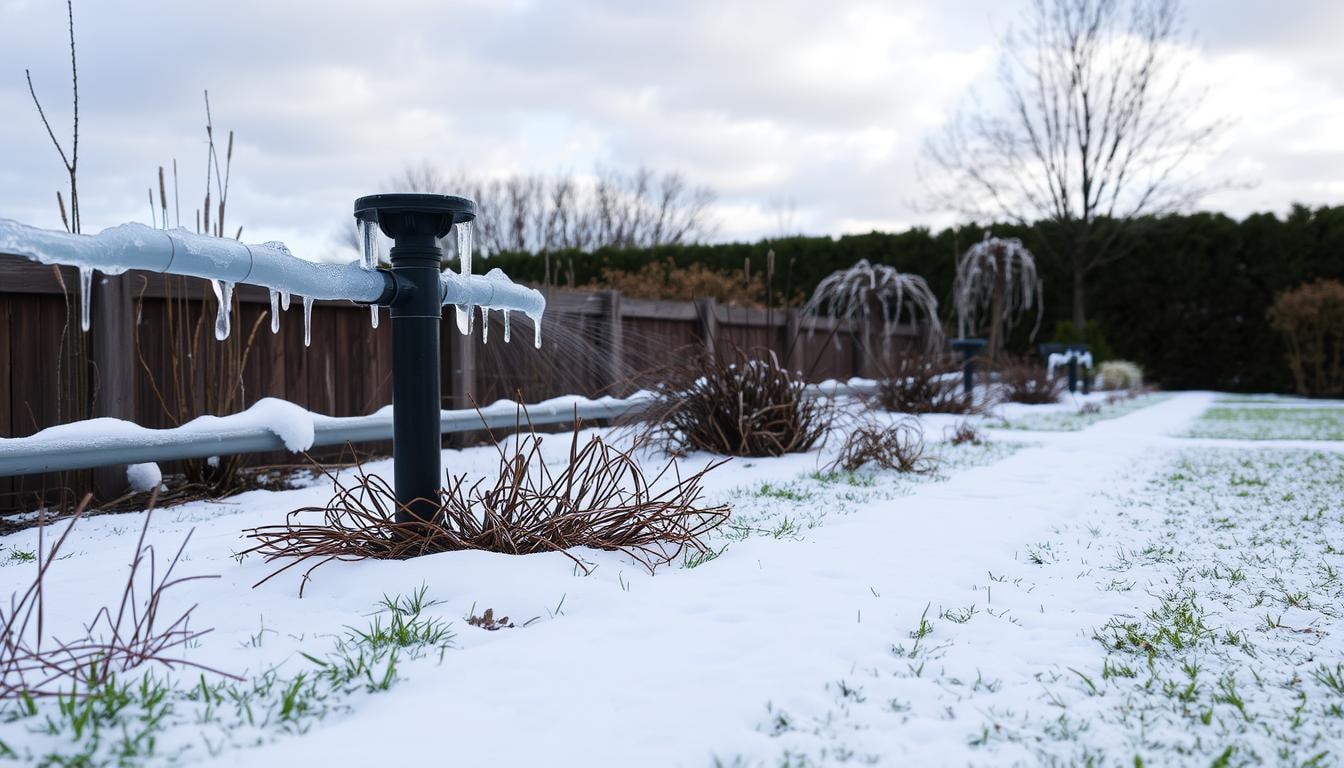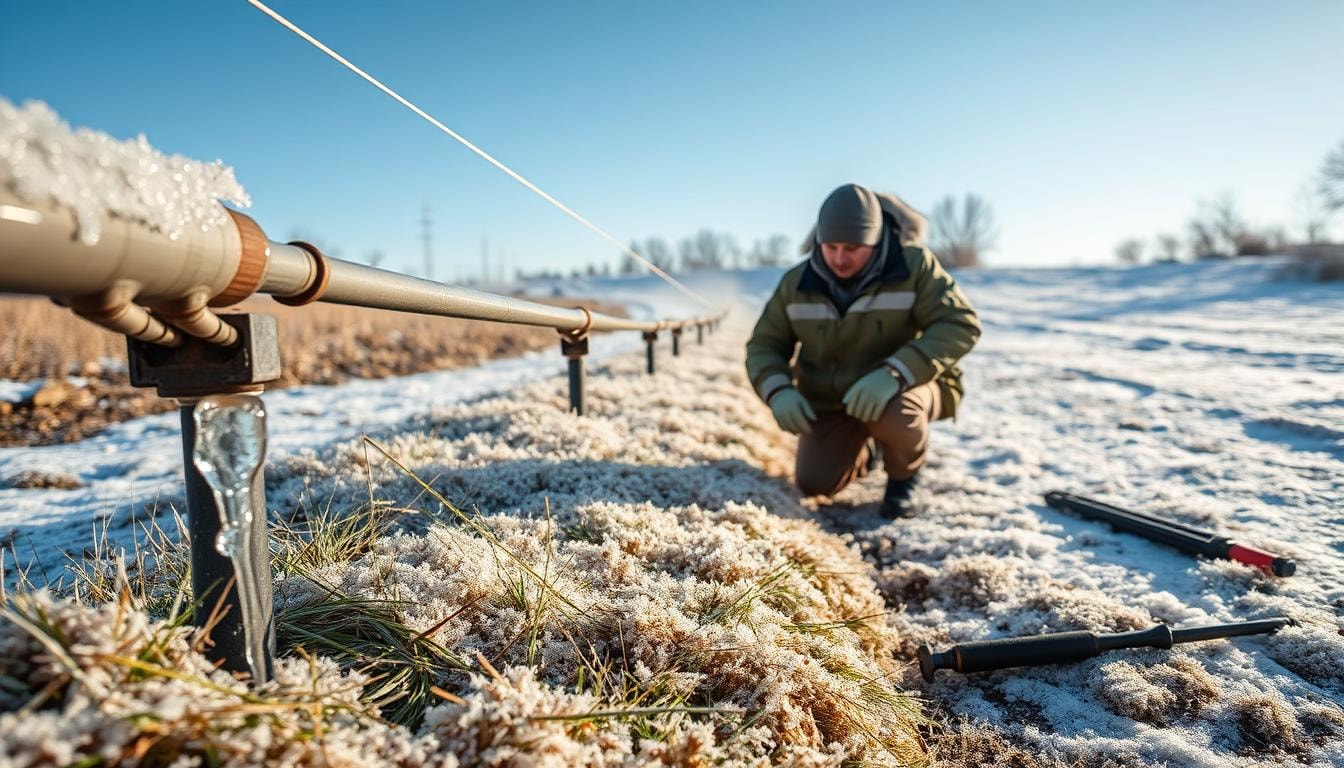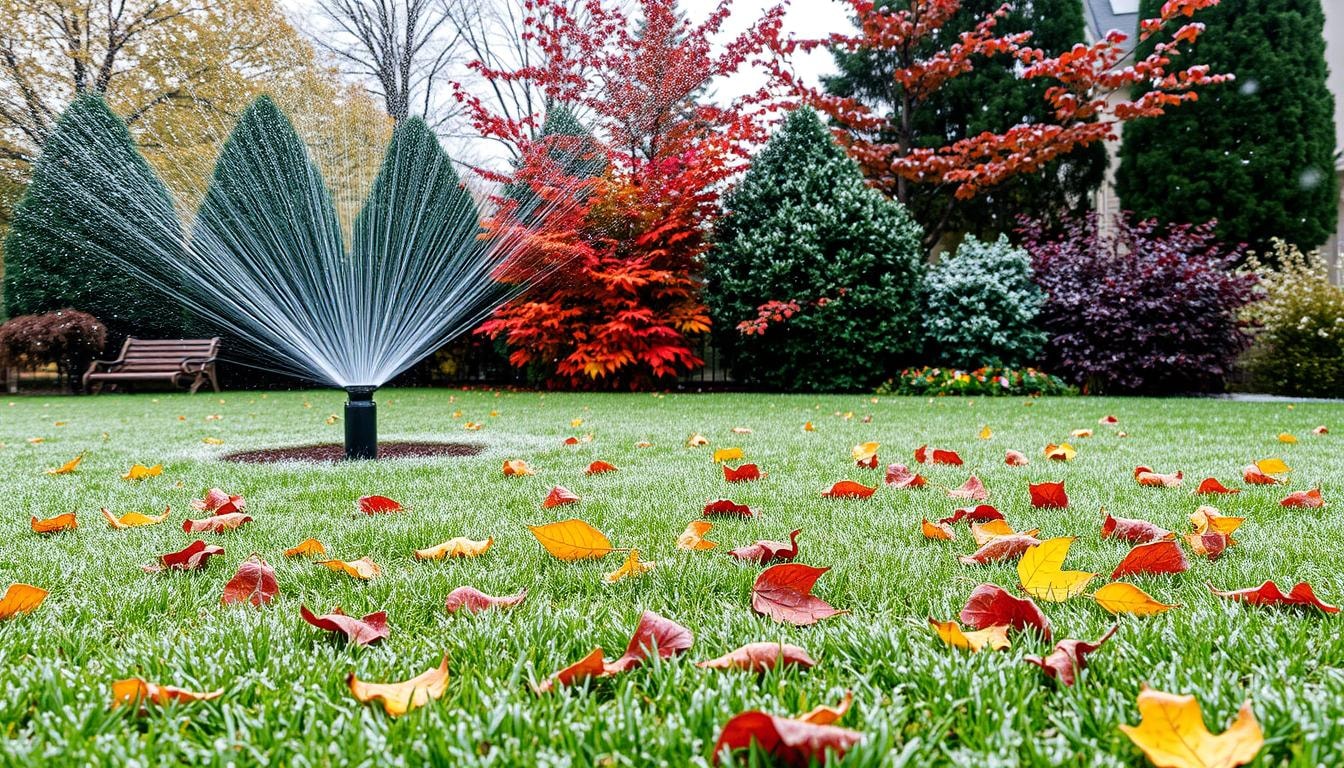Sprinkler Winterization Near You
Can’t find what you are looking for?
How It Works
-
Answer a few questions about your home project.
-
Within seconds, get matched with top-rated local pros.
-
Compare quotes and choose the best pro for the job.
Sprinkler Winterization In Your Area
Sprinkler Winterization: Protect Your System from Freezing
Meta Description: Learn how to properly winterize your sprinkler system to prevent freezing and costly damage. Protect your investment with expert tips for Sprinkler Winterization.

Worried about frozen pipes and costly sprinkler repairs? Cold weather is coming, so it’s time to protect your lawn investment. Sprinkler winterization is key to prevent damage from freezing temperatures.
Let’s explore expert tips to get your sprinkler system ready for winter. These steps will help your system withstand the cold and avoid costly repairs.
Key Takeaways
- Winterizing your sprinkler system is essential to prevent costly repairs from frozen pipes.
- Proper water removal methods, such as manual drain or compressed air blowout, are crucial for protecting your system.
- Insulating exposed components and managing valves can further safeguard your sprinkler system.
- Monitoring weather forecasts and taking immediate action during unexpected freezes can save your system from damage.
- Regular maintenance and professional winterization services can ensure your sprinkler system is ready for the cold season.
Understanding the Importance of Sprinkler Winterization
Cold weather demands sprinkler system winterization. This vital task prevents costly repairs and protects your lawn investment. Proper winterization stops pipes from freezing, avoiding major issues come spring.
Preventing Costly Repairs from Frozen Pipes
Skipping winterization can lead to cracked and burst pipes. This often results in expensive replacements and time-consuming repairs. Frozen water can also break sprinkler heads, causing irreparable damage.
Safeguarding Your Investment in Lawn and Landscape
Winterization protects your lawn and landscape investment. Freezing water can damage the sprinkler system manifold, which controls water flow. This can crack valves and require costly replacements.
Proper winterization helps avoid these expensive problems. It ensures your lawn stays healthy and beautiful for years to come.
Shut Off the Water Supply
Shutting off the water supply is crucial for winterizing your sprinkler system. Find the main shut-off valve and turn off the backflow preventer. This stops water from staying in the system and freezing.
- Locating the Main Shut-Off Valve: The main shut-off valve is usually near the water meter or on a pipe outside. It controls water flow to your entire property. Turn the valve a quarter turn right to shut off the water.
- Turning Off the Backflow Preventer: The backflow preventer stops contaminated water from flowing back into the main supply. It’s typically outside or in the basement. Find the two pipes connected to it and turn off one.
Shutting off the water supply and backflow preventer is a key winterization step. It keeps water out of the sprinkler system and prevents costly freeze damage.
Draining the Sprinkler System

Properly draining your sprinkler system is crucial after shutting off the water supply. This protects pipes from freezing and bursting during winter. Several methods can effectively remove remaining water from your system.
These include manual drain valves, automatic drain valves, and compressed air blow-outs. Each method has its advantages for winterizing your sprinkler system.
Manual Drain Valve Method
This method requires opening each zone’s drain valve manually. Water gradually drains out, preventing freezing inside the pipes. Ensure all valves are fully open for maximum water removal.
Automatic Drain Valve Method
Sprinkler systems equipped with automatic drains offer a convenient solution. As water pressure drops, these valves open automatically. This allows the system to drain itself without manual intervention.
Compressed Air Blow-Out Method
This method uses high-pressure air to expel water from sprinkler lines. It’s often considered the most thorough winterization technique. However, use appropriate air pressure to avoid damaging the system.
Proper drainage is key to protecting your sprinkler system. It helps prevent costly repairs in the future. Choose the method that works best for your system and needs.
Insulating Exposed Components
Protect your sprinkler system from winter’s chill. Insulating exposed parts prevents freezing, which can cause costly damage. This simple step is a smart investment for your home.
Look for exposed pipes, valves, and sprinkler heads. These parts are at risk in cold weather. In Michigan, temperatures can drop below freezing from November through March.
Use foam insulation tape or tubes to wrap exposed components. Find these materials at home improvement stores. Wrap them tightly around the parts for a snug fit.
Consider using special covers for extra protection. These products are made to withstand harsh weather. They add another layer of insulation to important areas.
Proper insulation is key to winterizing your sprinkler system. This task helps you avoid expensive repairs later. Take action now to protect your system all winter long.
Protecting Valves and Backflow Preventers
Safeguarding valves and backflow preventers is vital for your sprinkler system. Proper winterization prevents costly repairs from frozen pipes and water damage. Let’s explore how to protect these crucial components effectively.
Using Insulation Tape and Covers
Use high-quality insulation tape and covers for valves and backflow preventers. This helps keep heat in and stops freezing. Cover every part of the valve for maximum protection.
Thermacel Foam Pipe Insulation and Backflow Armor Insulated Pouch are great options. Don’t just insulate the valve or brass part. Cover everything to avoid freeze damage.
Ensuring Proper Ventilation
Insulation is crucial, but so is proper ventilation. Poor airflow can lead to moisture buildup and damage the system. Position insulation and covers to allow air circulation.
This balance between insulation and ventilation protects your sprinkler system from harsh winter conditions. Take care to maintain this balance for optimal protection.
Preparing for Unexpected Freezes

Unexpected freezes can damage your sprinkler system even after winterizing. Stay alert and ready to act quickly. This can save you from costly repairs and protect your investment.
Monitor Weather Forecasts
Keep an eye on local weather reports. Watch for sudden temperature drops during fall and winter. This helps you address potential freezing issues before they happen.
Take Immediate Action
- If a freeze is coming, protect your sprinkler system further. Drain it more thoroughly or add extra insulation to vulnerable parts.
- Act fast to prevent frozen pipes from bursting. Quick action can save you from expensive repairs.
- Keep supplies like foam insulation and pipe wrap tape on hand. These items help you address freezing concerns quickly.
Stay alert and act fast to protect your sprinkler system from unexpected freezes. This helps safeguard your lawn and landscape investment.
Sprinkler System Maintenance
Proper upkeep is vital for your sprinkler system’s effectiveness. Spring brings warmer weather, making it the perfect time for a thorough inspection. Check for any winter damage or issues during this startup process.
Spring Startup and Inspection
Carefully examine all parts of your sprinkler system after winter. Look for signs of damage, wear, or potential problems. This includes checking pipes, connections, valves, and sprinkler heads.
Ensure proper water pressure and flow. Address any necessary repairs or adjustments. This thorough check helps identify issues before they worsen.
- Cracks or leaks in pipes and connections
- Proper operation of valves and sprinkler heads
- Adequate water pressure and flow
- Any necessary repairs or adjustments
A thorough spring startup keeps your sprinkler system maintenance on track. It helps you spot and fix problems early, ensuring smooth operation during growing season.
Routine Checks and Repairs
Regular checks throughout the year are crucial. Address any routine checks and repairs as needed. This includes fixing leaks and broken sprinkler heads.
Adjust sprinkler heads for proper coverage. Prevent overspray to save water. Clean and maintain the backflow preventer and other system parts.
- Checking for and repairing any leaks or broken sprinkler heads
- Adjusting sprinkler heads to ensure proper coverage and prevent overspray
- Cleaning and maintaining the backflow preventer and other system components
- Monitoring the system’s spring startup and inspection for any changes or issues
Regular maintenance keeps your sprinkler system running smoothly. It helps prevent costly repairs in the future. Stay on top of these tasks for an efficient system.
Hiring Professional Winterization Services
Preparing your sprinkler system for winter is crucial. Professional winterization services can help avoid costly repairs. Experienced technicians have the skills to protect your system from harsh weather.
Many companies offer thorough winterization services. They inspect, turn off water, and empty the system. Some even provide a No Freeze Damage Guarantee™.
These services go beyond just winter prep. Many offer year-round maintenance packages. They can spot issues and suggest spring repairs.
Professional winterization services can save you time and money. They protect your lawn and landscape investment. Trusting experts ensures your system is ready for winter.
Find Pros for Your Sprinkler Winterization Needs
Don’t let the hassle of winterizing your sprinkler system leave you frustrated. FindPros can connect you with top-rated local professionals who specialize in preparing your irrigation system for the cold months. Simply answer a few questions about your sprinkler system and project needs, and we’ll match you with pros who can provide competitive quotes. Compare options, choose the best fit, and get your system properly insulated and winterized before the first freeze. Take the stress out of maintaining your sprinkler system with FindPros – the easy way to find skilled service providers for all your home projects.
Conclusion
Winterizing your sprinkler system protects your lawn and landscape investment. Follow these steps to shut off water, drain the system, and insulate exposed parts. This shields your sprinklers from freezing temperatures.
Skipping winterization can lead to costly damages and plumbing issues. Stay alert for surprise freezes. Regular maintenance keeps your system ready for warmer weather.
Sprinkler winterization is crucial for your outdoor space. It helps protect your sprinkler system and prevent freeze damage. Take action now to safeguard your investment for the next growing season.
Frequently Asked Questions (Sprinkler Winterization)
MOST POPULAR CITIES
Browse by State- Alameda
- Costa Mesa
- Laguna Beach
- Orange
- Alhambra
- Culver City
- Lancaster
- Oroville
- Anaheim
- Daly City
- Livermore
- Oxnard
- Antioch
- Davis
- Lodi
- Pacific Grove
- Arcadia
- Downey
- Lompoc
- Palm Springs
- Bakersfield
- El Centro
- Long Beach
- Palmdale
- Barstow
- El Cerrito
- Los Angeles
- Palo Alto
- Belmont
- El Monte
- Malibu
- Pasadena
- Berkeley
- Escondido
- Martinez
- Petaluma
- Beverly Hills
- Eureka
- Marysville
- Pomona
- Brea
- Fairfield
- Menlo Park
- Port Hueneme
- Buena Park
- Fontana
- Merced
- Rancho Cucamonga
- Burbank
- Fremont
- Modesto
- Red Bluff
- Calexico
- Fresno
- Monterey
- Redding
- Calistoga
- Fullerton
- Mountain View
- Redlands
- Carlsbad
- Garden Grove
- Napa
- Redondo Beach
- Carmel
- Glendale
- Needles
- Redwood City
- Chico
- Hayward
- Newport Beach
- Richmond
- Chula Vista
- Hollywood
- Norwalk
- Riverside
- Claremont
- Huntington Beach
- Novato
- Roseville
- Compton
- Indio
- Oakland
- Sacramento
- Concord
- Inglewood
- Oceanside
- Salinas
- Corona
- Irvine
- Ojai
- San Bernardino
- Coronado
- La Habra
- Ontario
- San Clemente